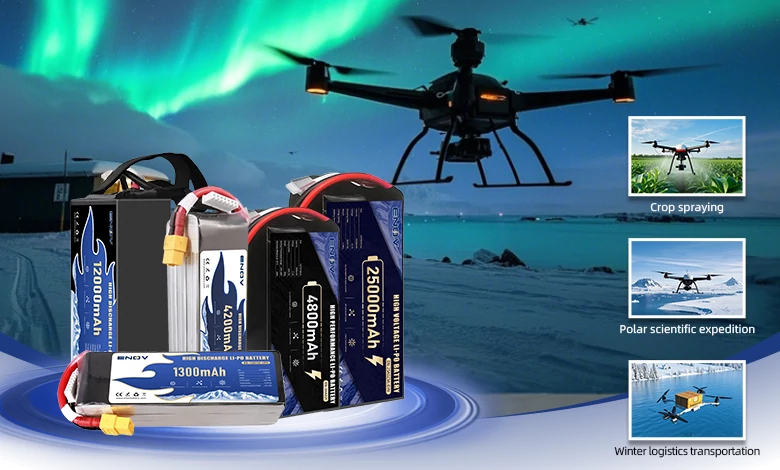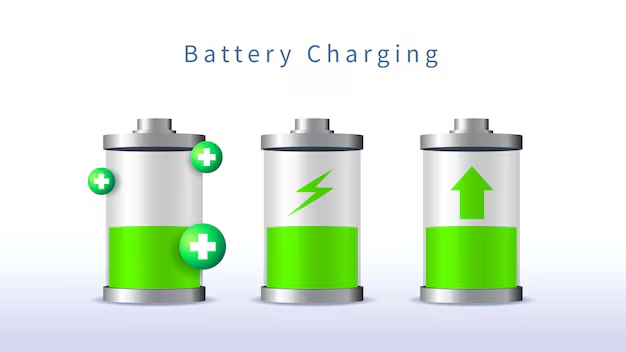Lithium Manganese Oxide Battery (LiMn₂O₄, LMO)

ENOV High-Energy drone batteries power industrial and commercial drones. Delivering 220–320 Wh/kg energy density, they enable long flight times (30+ mins) and support fast charging (2C). Perfect for aerial photography, surveillance, and delivery drones.
The lithium manganese oxide battery with liquid electrolyte is the mainstream type of lithium manganese oxide batteries. It uses lithium manganese oxide (LiMn₂O₄) as the core positive electrode material and is paired with a liquid organic electrolyte. Owing to its unique properties, it occupies an important position in specific fields. The following will elaborate on it in terms of basic composition, working principle, core performance, application scenarios, and usage precautions.
1. Basic Composition and Working Principle
(1) Composition of Core Materials
● Positive Electrode Material: Lithium manganese oxide (LiMn₂O₄) with a spinel crystal structure (space group: Fd3m) is adopted, which can provide a stable three-dimensional lithium-ion diffusion channel. Its chemical name is lithium manganese oxide, with a CAS number of 12057-17-9, a chemical formula of LiMn₂O₄, and a molecular weight of 180.81 g/mol. It appears as a black to gray powder with a melting point of 400 °C. In the crystal structure, equal amounts of Mn³+ and Mn⁴+ occupy octahedral sites, while lithium occupies tetrahedral sites, laying the foundation for lithium-ion migration.
● Negative Electrode Material: Graphite or other carbon materials are the mainstream choices. Some products will add lithium titanate to form a “lithium manganese oxide – lithium titanate” composite system, which improves the cycle stability and charge-discharge performance of the battery by optimizing the negative electrode structure.
● Electrolyte: A liquid organic electrolyte is fixedly used as the core medium for lithium-ion migration between the positive and negative electrodes. Its composition design directly affects the ion conduction efficiency and battery safety performance, and it is necessary to balance good ionic conductivity and chemical stability.
(2) Working Mechanism
The charge-discharge process of a lithium manganese oxide battery with liquid electrolyte is essentially a cycle in which lithium ions are intercalated into and deintercalated from the positive and negative electrodes with the help of the liquid electrolyte:
● Discharge Stage: Lithium ions are deintercalated from the negative electrode material, pass through the liquid organic electrolyte, and are successfully intercalated into the lattice structure of the positive electrode lithium manganese oxide. At the same time, electrons form a current through the external circuit to continuously supply power to external equipment, realizing the conversion of chemical energy into electrical energy.
● Charging Stage: Under the action of an external power supply, lithium ions in the lattice of the positive electrode lithium manganese oxide are deintercalated, migrate through the liquid electrolyte, and are re-intercalated into the structure of the negative electrode material. This completes the storage of electrical energy into chemical energy, preparing for the next discharge.
The nominal voltage of this type of battery is usually around 3.7 V, the actual output voltage range covers 2.5 V to 4.2 V, and the theoretical specific capacity is approximately 148 mAh/g. However, the energy density in practical applications will be affected by factors such as material properties and process levels.
2. Core Performance Characteristics
(1) Significant Advantages
● Outstanding Cost Advantage: Manganese is abundant in nature, with low mining and acquisition costs, and the battery production process is relatively simple. At the same time, the raw material cost and preparation difficulty of the liquid organic electrolyte are low, which jointly promote the reduction of the overall manufacturing cost of the battery. The cost of its positive electrode material is much lower than that of lithium cobalt oxide (LiCoO₂) and ternary materials (NMC), making it highly competitive in price-sensitive scenarios.
● High Safety: Lithium manganese oxide materials have good thermal stability, with a thermal decomposition temperature of approximately 250 °C and strong overcharge resistance. When paired with a liquid organic electrolyte, the probability of thermal runaway or explosion under extreme working conditions such as overcharge, over-discharge, and short circuit is low. Moreover, the battery has a stable chemical structure and good heat dissipation performance, and can adapt to a variety of complex usage environments.
● Excellent Rate Performance: The liquid organic electrolyte has good ion conduction efficiency, which can support the rapid migration of lithium ions, enabling the battery to have high-current charge-discharge capabilities and quickly output high power. It is perfectly suitable for scenarios that require short-term high-power output, such as power tools and automotive start-stop systems, and can still maintain stable performance under high-rate working conditions.
● Good Environmental Protection Characteristics: The battery composition does not contain toxic heavy metals such as cobalt and nickel. Although the liquid organic electrolyte requires professional treatment, the overall pollution to the environment is small, and the subsequent recycling technology is mature, which is in line with the industrial development trend of green environmental protection.
● Excellent Low-Temperature Performance: In low-temperature environments, the liquid organic electrolyte can still maintain a certain ion conduction capacity, allowing the battery to maintain good discharge performance. It is suitable for use in cold regions or winter and has obvious application advantages in low-temperature scenarios.
(2) Main Disadvantages
● Short Cycle Life: During the charge-discharge cycle, manganese ions are easily dissolved into the liquid organic electrolyte, leading to the collapse of the positive electrode structure and subsequent capacity fading. The cycle life of ordinary lithium manganese oxide batteries with liquid electrolyte is only 300-500 times, and even after improvement, the cycle life is only 600-800 times, which is much lower than that of ternary lithium batteries (1000-2000 times) and lithium iron phosphate batteries (more than 2000 times). Moreover, under high-temperature or deep charge-discharge conditions, the dissolution rate of manganese ions accelerates, and the life fading is more significant.
● Low Energy Density: The volumetric energy density is approximately 300-400 Wh/L, and the actual gravimetric energy density is only 100-120 Wh/kg, which is less than half of that of lithium cobalt oxide batteries, and also lower than that of ternary lithium batteries (about 200 Wh/kg) and lithium iron phosphate batteries (140-160 Wh/kg). The theoretical specific capacity (100-120 mAh/g) is also at a relatively low level, which limits its application in scenarios with high endurance requirements.
● Poor High-Temperature Performance: When the ambient temperature exceeds 60 °C (above 55 °C in some scenarios), the activity of the liquid organic electrolyte increases significantly, accelerating the dissolution of manganese ions from the positive electrode into the electrolyte, resulting in a decrease in the structural stability of the positive electrode and a significant acceleration of battery capacity fading. At the same time, high temperatures may cause the decomposition of the electrolyte, increasing the internal pressure of the battery and posing potential safety hazards.
● Poor Storage and Capacity Stability: The battery capacity fluctuates greatly, with a monthly decay rate of more than 5%, making it unsuitable for long-term storage. During long-term storage, the liquid organic electrolyte may react slowly with the electrodes, leading to a significant decline in battery performance, and it has poor adaptability to scenarios that require long-term backup.
● Low Voltage Platform: The average operating voltage is approximately 3.7 V, slightly lower than that of lithium cobalt oxide batteries (3.8 V). Under the same discharge duration, the output power is relatively low, and its adaptability to scenarios with high power requirements is limited.
3. Typical Application Fields
Relying on its advantages of low cost and high safety, lithium manganese oxide batteries are widely used in many fields. However, due to performance shortcomings, their application scenarios have certain limitations, as follows:
● Power Tool Field: Equipment such as electric drills and lawnmowers have high requirements for the high-rate discharge performance of batteries. This type of battery can meet the demand for short-term high-power output and has obvious cost advantages, making it the core power source choice in this field to ensure the continuous and stable operation of tools.
● Small Transportation Vehicle Field: In the early stage, it was widely used in electric bicycles, electric motorcycles, and some low-speed electric vehicles (such as elderly scooters). In the field of electric vehicles, it was used in early models such as the first-generation Nissan Leaf. Currently, it is still used in some small electric vehicles (such as Wuling Hongguang MINI). At the same time, it is also suitable for use as an auxiliary power source in hybrid vehicles, working in conjunction with other types of batteries to balance cost and performance.
● Energy Storage System Field: It is suitable for small and medium-sized energy storage scenarios that are cost-sensitive and have low energy demand, such as household energy storage battery systems and uninterruptible power supplies for communication base stations. It can also be used in grid energy storage systems to store renewable energy such as solar energy and wind energy, providing support for energy allocation.
● Consumer Electronics and Special Equipment Field: It is widely used in portable small household appliances (such as sweeping robots) and automotive start-stop systems (start-stop batteries require rapid charge and discharge). It can also be used in automated guided vehicles (AGVs) for intelligent warehousing, special engineering vehicles, and electric wheelchairs. In the field of medical equipment, it is suitable for portable diagnostic tools, monitoring equipment, and other devices that have requirements for safety and stability. In the aerospace field, due to its ability to work in a wide temperature range and reliable performance, it can be used in power supply systems of satellites and spacecraft. At the same time, it is also applicable to military and national defense equipment to meet their requirements for power supply reliability and safety.
4. Usage Precautions
To ensure the safe and stable operation of lithium manganese oxide batteries with liquid electrolyte and extend their service life, the following points should be noted during use:
● Avoid Use and Storage in High-Temperature Environments: High temperatures will accelerate the dissolution of manganese ions into the liquid electrolyte, leading to rapid capacity fading of the battery, and may also cause the decomposition of the electrolyte, increasing potential safety hazards. Therefore, it is necessary to avoid placing the battery in a high-temperature environment above 60 °C for operation or storage.
● Adopt a Shallow Charge and Shallow Discharge Usage Strategy: Try to avoid deep discharge of the battery (e.g., power below 20%) and overcharging, reduce the damage to the positive electrode structure caused by deep charge and discharge, slow down the rate of capacity fading, extend the cycle life, and at the same time reduce the probability of side reactions between the electrolyte and the electrodes.
● Reasonably Plan the Storage Cycle: Due to the battery’s monthly capacity decay rate of more than 5%, it is not suitable for long-term idle storage. If storage is necessary, the battery should be kept in a half-charge state (approximately 50% charge), and the charge should be supplemented regularly. At the same time, a cool and dry storage environment should be selected to avoid electrolyte deterioration or electrode corrosion.
● Prevent Electrolyte Leakage: Leakage of the liquid electrolyte may cause safety issues. During use, it is necessary to avoid severe impact, extrusion, or puncture of the battery to prevent damage to the shell and subsequent electrolyte leakage. If electrolyte leakage is found, the battery should be stopped using immediately and properly handled.
5. Summary
Lithium manganese oxide batteries with liquid electrolyte, relying on advantages such as low cost, high safety, good rate performance, and excellent low-temperature performance, still have irreplaceability in specific fields such as power tools, small energy storage, and some transportation vehicles. However, affected by shortcomings such as short cycle life, low energy density, and poor high-temperature performance, they have gradually been replaced by ternary lithium batteries or lithium iron phosphate batteries in mainstream fields such as electric vehicles that have high requirements for endurance and long-term reliability. Currently, they are more used as “auxiliary batteries” in combination with other types of batteries.
In the future, with the breakthroughs in technologies such as positive electrode doping modification and electrolyte formula optimization, the performance shortcomings of lithium manganese oxide batteries with liquid electrolyte will be gradually improved, and they are expected to continue to maintain competitiveness in the mid-to-low-end market. When enterprises select batteries, they need to comprehensively consider factors such as the usage environment, life requirements, and maintenance costs, rather than only focusing on the initial purchase price, to maximize the overall application benefits.
Quick inquiry
Drop us a line, and we’ll get back to you within 24 hours.

Ariana Yuan
Digital Operations Manager
Website Planning|Marketing Project Management for Drone Batteries|Scheduled Content Refresh|SEO Optimization

Ariana Yuan
Digital Operations Manager
Website Planning|Marketing Project Management for Drone Batteries|Scheduled Content Refresh|SEO Optimization




